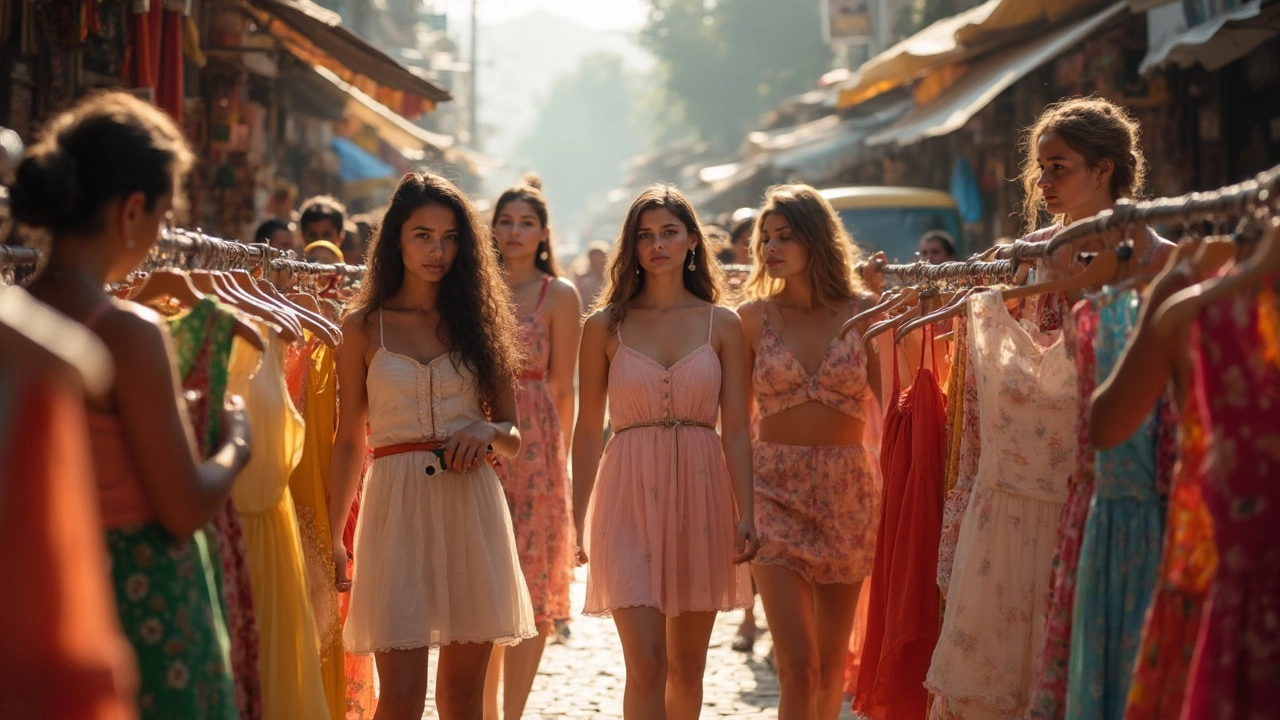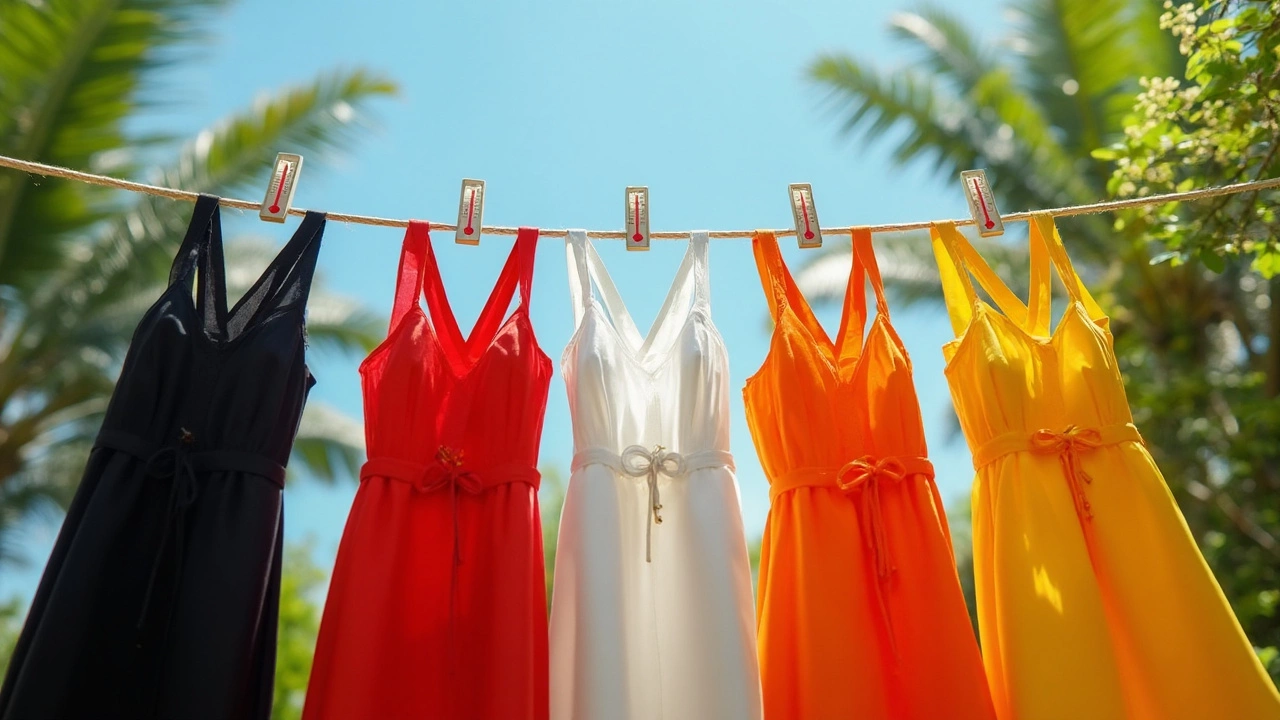What Colors Not to Wear When It's Hot: Summer Dress Survival Tips

Ever notice how some clothes make you feel like you’re melting under the sun, while others barely faze you? Color plays a huge role in this. If you pick the wrong shade, you’ll find yourself baking on a July afternoon—even if your dress is as light as a feather.
The science is simple: dark colors soak up more heat, while light ones tend to reflect it. That’s why your black summer dress feels five degrees warmer than the white one hanging next to it in your closet. But not all light colors are a free pass, either. Some shades might surprise you with how stuffy or revealing they can get when the sun's pounding down.
So if you want to look good and dodge the sweat, it pays to know exactly which colors to sidestep. There’s more to it than just “don’t wear black.” It’s about choosing fabrics and shades that actually help you stay cool, no matter what your style is.
- How Color Impacts Your Body Heat
- The Worst Colors to Choose on Hot Days
- Extra Annoyances: Stains, Sweat, and See-Through Fabrics
- Smarter (and Cooler) Alternatives
How Color Impacts Your Body Heat
The color of your summer dress matters more than you think on a blazingly hot day. Here’s why: colors actually change how much heat your clothes trap from the sun. Put simply, dark shades like black, navy, and deep greens absorb most of the sun’s energy. That means your dress gets hotter, and so do you. Meanwhile, light colors like white, pale pink, or beige reflect most of the sunlight. That reflected light means less heat clings to your skin.
Black clothes can get super hot. A fun experiment—try touching a black and a white T-shirt after they’ve been in direct sunlight. The black one will almost always feel way warmer. Scientists have measured this: a dark shirt can absorb up to twice as much heat as a white one in strong sunlight. No shocker, but it really makes a difference in how much you sweat when the heat cranks up.
Here’s a quick look at how different shades compare with heat absorption when you’re picking out summer dresses:
| Color | Heat Absorption |
|---|---|
| Black | Highest |
| Navy | High |
| Red | Moderate |
| White | Lowest |
| Light Colors (Yellow, Pale Blue) | Low |
So, if you want to stay comfortable in hot weather, color isn’t just a fashion choice—it’s a practical one. Wearing dark colors in summer is almost like walking around with a space heater strapped to your back. Save those outfits for cooler months and stick with lighter options when the sun’s blazing.
The Worst Colors to Choose on Hot Days
You’ve probably heard that black is public enemy #1 when it comes to summer dresses in the heat. Black and other dark colors absorb much more sunlight than their lighter counterparts. That means they actually soak up the sun’s rays and trap more heat against your skin, which is the last thing you want when it’s hot and humid.
But it’s not just black—navy, charcoal, deep brown, and forest green all fall into this heat-trapping club. They might look sleek, but they’ll have you sweating before you finish your iced coffee.
- Black: Absorbs more than 90% of incoming sunlight, making it scientifically proven to heat up the most.
- Navy and Dark Blues: Almost as bad as black. They don’t reflect much light and can make you feel stuffy.
- Dark Browns and Greens: These shades look earthy but behave like a thermal trap.
- Deep Purple: Dark purples can act similar to black, swallowing sunlight instead of bouncing it away.
A quick fact worth remembering: In a simple test comparing black and white shirts left in the sun, the black one can be up to 10°C (that’s around 18°F) hotter after an hour. That’s a massive difference just because of color.
Another catch: super bright colors like neon orange or lime might not absorb tons of heat, but they can make sweat stains way more obvious, especially in thin fabrics. Burgundy, maroon, and even dark reds are similar—they’re less forgiving with sweat marks, and the heat factor is still high.
So if you’re eyeing a stylish summer dress for your next outing, steer clear of these shades when temperatures climb. You can always bring them back out for cooler evenings or indoor events with better air conditioning.

Extra Annoyances: Stains, Sweat, and See-Through Fabrics
Hot weather doesn’t just make you sweat—it makes some summer dresses a magnet for stains and awkward transparency problems. Even if you pick a light color to beat the heat, not all shades and fabrics treat you the same in the sun.
Let’s talk sweat spots first. Super light dresses, like pastels, pale gray, or light blue, might look cool but show sweat marks way more than you’d expect. White does a bit better at hiding it, but anything in the pastel or “ice cream” range can turn patchy if you’re walking or moving around a lot. Worse yet, yellow is almost famous for darkening right where you least want it—a total mood killer for what should be an effortless look.
- Hot weather = more sweating, especially in synthetic fabrics and tight fits.
- Light colors show sweat lines more, except for true white or busy floral prints that hide stains.
Then there’s the see-through issue. Super thin fabrics—think white and some pastel linen or cotton dresses—can become slightly transparent in the bright sun or when wet. Suddenly, you’re showing off a lot more than your summer style. Check your dress in sunlight before you head outside, not just under bedroom lights, or layer with a slip or nude-toned underwear.
Food and drink stains love summer, too. Ketchup, coffee, ice cream—almost every popular summer snack leaves a visible mark on pale colors. The truth is, richer shades like navy or deep green do way better at hiding life’s little accidents without boiling you like black does.
| Color | Shows Sweat | See-Through Risk | Stain Visibility |
|---|---|---|---|
| White | Low | High | High |
| Pale Blue | High | Medium | High |
| Yellow | Very High | Medium | Very High |
| Navy | Low | Low | Low |
If you’re looking to stay fresh and unstained in your summer dresses, go for busy patterns or go for shades like taupe, beige, or small florals that hide sweat and stains better. And always check your look in different light before heading to the BBQ.
Smarter (and Cooler) Alternatives
If you’re tired of feeling like your clothes are trapping heat, it’s time to shake up your summer wardrobe. The good news? You’ve got plenty of stylish options that also keep you dry and comfortable. Picking the right colors isn’t rocket science—sometimes, it just means skipping the obvious and going a shade lighter or softer.
Let’s break it down. White is hands down the best choice for summer dresses in the heat. It reflects the most sunlight, so you’re less likely to get overheated. Pastels—think pale pinks, soft yellows, powder blue, and mint—also bounce back a ton of heat. These shades have another hidden perk: they’re less likely to show sweat stains compared to bolder colors (a win if you run hot like me).
If you want a splash of color without feeling stuffy, try these:
- Sky blue: Looks cool, feels cool, and never goes out of style.
- Soft lavender or light lilac: Delivers a gentle pop but doesn’t trap heat.
- Light gray: Not too bold, hides marks better than white, and still reflects plenty of sunshine.
- Beige or pale tan: Works with almost anything, looks chic, and won’t make you feel like you’re roasting.
Fabric matters as much as color. Stick to natural, breathable materials like cotton or linen. Studies from the American Academy of Dermatology say these fabrics let sweat evaporate faster, which means you cool down quicker and smell fresher. Synthetic fabrics, on the other hand, can make you feel even hotter—even if the color looks safe.
Want some proof? This quick table lays it out:
| Color/Fabric | Sunlight Absorption | Best For |
|---|---|---|
| White cotton | Low | Hot sunny days, outdoor events |
| Pale blue linen | Very low | Travel, casual wear |
| Pastel rayon | Medium | Parties, times you still want to look dressed up |
| Dark polyester | High | Avoid on hot days |
One last tip: pay attention to lining. If your summer dress has a built-in slip in a dark color, it might heat you up even if the outside is light. Go for dresses lined in similar light shades or breathable mesh. You’ll feel cooler, and you’ll look put together no matter what summer throws at you.